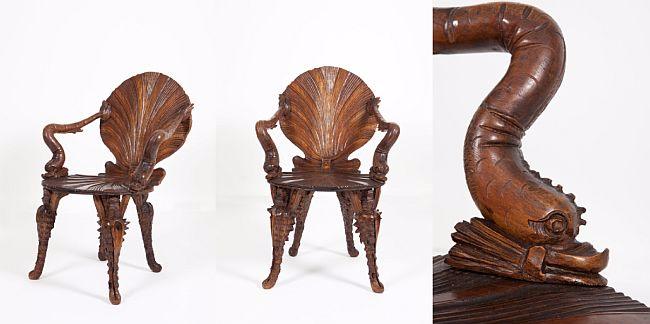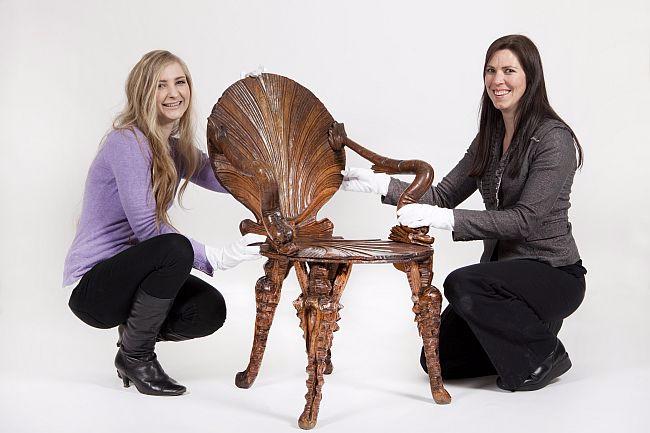A hardworking and honest man, Professor John Macmillan Brown (1846-1935) was born with a remarkably inquisitive nature and an ardent interest in the world around him.1 His academic pursuits were extensive and his talents considerable; his explorations took him to many significant locations around the world. One of Macmillan Brown's greatest delights was travelling to new and different places, and over the years his academic interests had taken him to many parts of the Pacific. These journeys were often lengthy and demanding, but clearly beneficial in assisting Macmillan Brown with the development of his interests in these areas.2

John Macmillan Brown's Venetian Grotto Chair
The Story of a Very Special Chair:
One of Macmillan Brown's greatest delights was travelling to new and different places. In Venice he bought two shell chairs and sent them on by steamer to New Zealand. Check out John Macmillan Brown's Venetian Grotto Chair.

19th Century Venetian Grotto Chair, hand carved walnut
Whilst Macmillan Brown possessed a deep fascination with the Pacific region, he also had strong curiosities about Europe. One particular venture to Italy with his wife Helen Connon (1857-1903) eventuated in the purchase of two Venetian grotto chairs. The purchase of these chairs, bought in approximately 1900, was not detailed in his journals from the time. However the chairs were important enough to him to be mentioned in his memoirs.
"In Venice we bought two shell chairs and a shell seat such as have been made there for centuries. We sent them on by steamer to New Zealand and found when we had to pay the freight that it was far more that what the actual articles cost us to buy in Venice."3
One of these remarkable chairs has been kindly donated to the University of Canterbury by June Sutherland (b. 1927). The chair had been passed on to Miss Sutherland by her mother Emily Sutherland (1880-1956) who was a housekeeper at Holmbank, Macmillan Brown's Cashmere home, during the early 1930s. After his death in 1935, the Sutherlands moved into Holmbank to house-sit for a period of time, as the vast library was being recorded for its donation to the University. It was during this period that the chair set became available for purchase. Emily Sutherland purchased one of the chairs, while her neighbour Jean Dunstan obtained the other. Miss Sutherland, who was a child at the time, fondly remembers the chairs being situated in the entrance hallway of Holmbank. The acquisition of the chair enabled the Sutherlands to have a continuing memory of their time at the historic homestead.4 With the passing years the chair became rather damaged, however with the help of expert hands, it has now been restored to its former glory.
In New Zealand the Venetian grotto chair is rare; apart from its matching partner, it seems there are no other examples of it in New Zealand today, but similar chairs can be seen in antique shops overseas. An example of fantasy furniture dating back to the mid nineteenth century, the chair is nautical in theme and eclectic, bringing together an interesting mix of Venetian and Rococo ideals.5
The Rococo period spanned from 1725 to 1775 and reached the height of its popularity in France, where furniture became more playful, ornate and curvaceous.6 The popularity of Rococo furniture spread throughout Europe, and during the nineteenth century designers looked to past centuries of decoration and form to recreate and revive furniture design.7
This sculpted wooden chair, in the elaborately carved style of Rococo revival, has been carved out of walnut (juglans regia), a wood indigenous to Southern Europe and popular in the creation of Renaissance and Rococo revival furniture.8 Natural wood became a favoured aesthetic for chairs in Italy throughout this period, with Italian walnut and its dark pigment being the predominant fashion.9
The chair has been conceived with three main components. The back and seat of the chair is an open scallop shell, its ridges forming a curvaceous symmetry. The arms are stylized dolphins, the most delicate part of this exquisite design, complete with eyes and fins. The legs are sculpted in a rocaille form of decoration.10 The word rocaille derives from the French words roc meaning 'rock' and coquille meaning 'shell'. Rocaille is a word associated with the Rococo style, and refers to the decoration seen in artificial grottos, combining the use of stones and shells.11 This style is used in the sculpting of the legs, which look like splayed coral, or a mix of rocks which seem quite reptilian in nature.
There have been varying designs for this chair, many of which exclude the dolphin arms. Similar chairs, but not quite as fantastical as this one, were made from mahogany during the reign of King George II from 1727 to 1760 in England.12 Apart from small variances, a chair of this kind can often be found in dark, natural walnut as well as gilded in silver or gold. Ornate and playful, the main and most striking component of this chair is the scallop shell back and seat.
The significance of the shell in this chair can not be understated. As one of nature's most unique and stunning creations the shell has been hugely important, not only practically but also aesthetically. Shells have been utilized in numerous ways and are rich with different meanings. In particular, shells have provided for people of the Pacific and the Caribbean; shells were crucial for the production of weaponry and tools, while the substance of shells have been depended upon as a natural source for food.13
All around the world, shells have been used as an aesthetical element and were frequently used in architecture, jewellery, clothing and artworks. One of the most prevailing and admired shells to have appeared across the centuries is the scallop shell (pectin sp.), appearing far and wide since classical antiquity. It is the refined, elegant curves and symmetry of the scallop shell that have inspired imagery over the ages.14 The scallop form became increasingly popular between the fifteenth and nineteenth centuries, as focus on classical, organic and symmetrical forms became more and more popular.15 As the scallop form gradually became more used in architecture, its popularity started to be reflected in additional ways, predominantly having a vast influence on Italian Renaissance and Rococo furniture.16
Furniture makers in Venice were very prolific in their seating designs,17 and were particularly known for chairs that had nautical themes.18 Shells, coral, dolphins and seahorses were often sculpted into chairs that took inspiration from the designs of Venetian grottoes. First created by the ancient Greeks, the grotto was formed out of caves situated near a water source and decorated with tufa, stones and shells. The grottoes acted as shrines, a restful space to pay respect to the spirits of water. In the Renaissance, grottoes became a popular addition to the landscapes of villas for those who could afford it. The Italian landscape designers revived and created a new tradition of grottoes, elaborately decorated into man-made monuments of natural beauty. The Renaissance grotto symbolized the quest for knowledge and an awareness of one's surroundings.19
The Italian grotto style peaked during the nineteenth century, and furniture was created to reflect this passion for nautical themes.20 From the mid to late nineteenth century, furniture makers in Venice fashioned chairs based on the feel of the grotto, creating an eclectic mix of Renaissance and Rococo inspired sculpted imagery.21 The nineteenth century Venetian grotto chairs were most likely intended for hallways and were aimed to be sold to visitors on their European tour.
The Venetian grotto chair incorporates ideas of the Rococo period as well as nautical themes that were popular during the nineteenth century, creating a chair that is captivating as well as beautifully detailed. This particular example clearly captured the attention of John Macmillan Brown, with its lively and distinct details suggestive of the Pacific he so admired. Considering his immense interest in the Pacific, it is not hard to comprehend why he must have been fascinated by this exquisite chair.

Postgraduate student Bryany Joslen and UC Art Curator Lydia Baxendell with the chair
Researched and written by Bryany Joslen as part of the 75th Anniversary celebrations surrounding John Macmillan Brown, University of Canterbury, 2010. Completed as a component of Joslen's internship with the UC Curator in conjunction with the Art History Postgraduate Curatorship Programme.
Footnotes
1. Cherry Hankin, 'Brown, John Macmillan 1845 - 1935', The Dictionary of New Zealand National Biography, vol. 2, 1870-1900. Bridget Williams Books and Dept. of Internal Affairs, 1993, p. 59.
2. Ibid.
3. John Macmillan Brown, The Memoirs of John Macmillan Brown, Christchurch, Whitcombe & Tombs for The University of Canterbury, 1974, p. 199-200.
4. June Sutherland, interview with the author, 10th October 2010.
5. Christopher Payne, 19th Century European Furniture (Excluding British), Woodbridge, Antique Collector's Club, 1981, p. 18.
6. Ibid., p. 18.
7. Ibid., p. 17.
8. Ibid., p. 503.
9. Adrianna Boidi Sassone [et al], Furniture: From Rococo to Art Deco, Köln, Evergreen, 2000, p. 342.
10. Ibid., p. 61.
11. Ibid., p. 224.
12. Helaine Fendelman., & Joe Rosson, 'Myth Inspires Grotto Chair', The Times-Transcript, May 31 2001, Retrieved October 11, 2010 from ProQuest Central, p. 1.
13. Ingrid Thomas, The Shell: A World of Decoration & Ornament, London, Thames & Hudson, 2007, p. 10.
14. Ibid., p. 164.
15. Ibid., p. 165.
16. Joseph Aronson, The Encyclopedia of Furniture, New York, Crown, 1938, p. 169.
17. Adrianna Boidi Sassone [et al], Furniture: From Rococo to Art Deco, p. 61.
18. Christopher Payne, 19th Century European Furniture, p. 414.
19. Ingrid Thomas, The Shell, p. 166.
20. Ibid., p. 168.
21. Ibid., p. 212.
